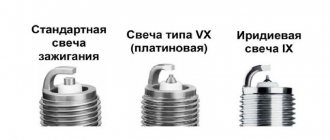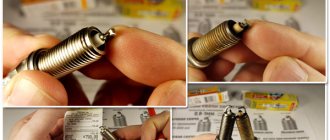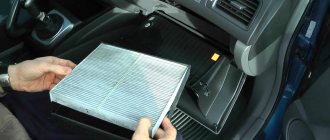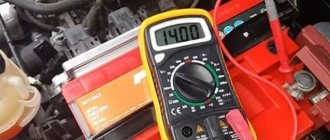- home
- car battery
- …
Any rechargeable battery is simply a battery and has its own service life, unfortunately, nothing lasts forever! However, ordinary acid batteries can have a fairly large “run” in their service life (sometimes doubled) - but what is this connected with? Why can some batteries last almost 10 years, while others barely last up to 3 years? It turns out there is a difference, and this specifically affects the life of our battery...
At the beginning of the article, I would like to note that today we will be disassembling ordinary acid batteries; however, gel and AGM batteries are a little different.
Battery life is affected by many different factors. Especially external ones, let's list them point by point:
- Temperature
- Battery version
- Vehicle charging system is working properly
- Leakage current
- City riding
- Battery mount
These are the main points that can extend the life of your battery, and a lot! However, first I want to talk about the quality of the batteries currently produced.
Quality and service life
At the very beginning I would like to say about the quality of modern batteries; now I will not get into the weeds with brands. Just want to point out:
- Now there are really decent batteries that last 5–7 years , and possibly more. It is quite simple to distinguish them; firstly, it is a well-known brand, and secondly, it has a 2-4 year warranty. As a rule, they are made using maintenance-free technology to prevent the hands of inquisitive owners from getting into them.
- There are also not very good batteries; their service life is limited at best - three years ! But they only provide 6-12 months of warranty service for their products.
The difference between a bad and a good manufacturer lies in the battery production technologies themselves; I read somewhere that serious companies do not spare lead for the plates, and also use calcium and even silver to reduce the electrolysis processes - so they obviously last quite a long time! But for those who save, the batteries will work very little, because there is a small amount of lead in the plates and after 2–3 years it begins to crumble. So when choosing a new battery (I advise you to read the article), you need to look first at the warranty and technology, you will already be able to understand everything.
Well, now I’ll try to quickly go over the main points that I indicated above.
How can I find out the release date and where can I see the manufacturing numbers?
Manufacturers always indicate the production date of the battery on the packaging, but the markings are different for each manufacturer, so you need to check with the seller , since determining the production date yourself will be problematic.
Advice. There are no standards for applying the production date to batteries, but in most cases, manufacturers indicate the production date in the form of a set of letters and numbers on the battery cover; you can check it on both the front and side labels.
In addition to consulting the seller, visiting the official website of the manufacturer can help decipher the date.
How to calculate?
On a working car, the battery life is determined by the mileage of the car and the operating time of the battery itself. The car's mileage is more than 100,000 km and the battery has been used for more than 3 years, which is a direct indication for replacing the battery. But these are general recommendations; with proper care, the battery can last much longer, which is why it is so important to calculate its operating time.
To determine the initial data required:
- Load power.
- Inverter efficiency.
- Battery voltage.
- Backup time.
- Lifetime.
The operating time is calculated using the formula:
t=Uacc. *C*K*H*Kr. /P where:
- t – operating time (for example, 5 hours);
- Ub. – battery voltage, (12V);
- C – capacity (Ah);
- K – number of batteries in the system (1 pc);
- N – inverter efficiency (0.82);
- Kr – discharge depth coefficient (80%);
- P – load power (150W).
We find the battery capacity C using the formula: C = P / Ubattery. * t / K / H / Kr , substituting the values, we get 150 / 12 x 5 / 1 / 0.82 / 0.8 = 95.3.
Selecting the right battery ensures that the battery discharge will not exceed 80%. Required shock frequency: 10 years x 365 days / 500 cycles = 7.3 days.
Battery operating time is measured in years and service life in operating cycles. The cycle is the time from full charge to discharge of the battery. The endurance of the battery in cycles is calculated for typical operating conditions (temperature 20°C, discharge with a current of the same value).
In this example, we find that under standard operating conditions, one cycle will take about 7 days (round the value to 7.3). We get a battery life of 10 years, provided that the cyclic resource is not exhausted earlier.
Temperature
It should be noted that many motorists think that the service life is affected by the winter period, that is, the battery “freezes”, loses its charge and fails. This is partly true - the main problem is a cold battery, even after starting it does not take a charge normally until its temperature rises to above zero. Therefore, short trips can really have a detrimental effect on the battery, but as a rule, we all warm up the car and do what we do (as I think is correct), and therefore the charge accumulates normally.
But the summer mode, with its extremely high temperatures, and under the hood it can be + 60, + 70 degrees Celsius. Compromises battery sulfation ; in summer you don’t need much energy to start the engine, but in winter you need at least 30% more! And since the capacity sank in the summer, it’s possible that you won’t be able to start the engine!
desulfating the battery at least once every 2-3 years , this way you will extend the service life by at least a couple of years.
Battery version
I wrote about this in the article - serviceable or maintenance-free battery . Actually, if you take a serviced option, then be prepared to take care of it! Add distilled water, check the electrolyte density, etc.! If you “miss” the moment, then the battery may not last for a year! In this regard, the service life of a maintenance-free battery is much longer, but it is still worth buying it.
Age verification
Timely replacement of the old battery is only possible if the owner carefully monitors and records all dates for replacing components. It is simply impossible to keep all the information in your head, especially considering that a high-quality battery can last 5 years or more. In addition, sometimes car enthusiasts buy used cars. You should not trust the seller unconditionally. The battery life can be easily checked.
We recommend: Titan Euro Silver car battery
There are no universal rules for date placement. Different manufacturing companies have different labeling methods. Well-known Western brands (Bosch, Berga, Balckmax, Varta, etc.) have a code of 24 characters. The fourth position from the left indicates the year of production, and the fifth and sixth positions indicate the month.
The Titan Arctic and Titan companies have the month and year positions swapped. You can find information about the year of manufacture on the fifth and sixth digits, and the month of manufacture under the third and fourth serial numbers. A special system was introduced by battery manufacturers Bost and Atlas. When searching for the year of manufacture, you should pay attention to the first digit. Behind it you can find letters that indicate the month of production.
Information about age verification methods can be obtained from your retailer or online. Operating instructions for each model are most often freely available. With such information, you can closely monitor the service life and carry out timely maintenance and replacement.
Vehicle charging system is working properly
Here I would like to highlight two main aspects:
- Generator - it directly affects the operation of the battery. If it works in its normal mode, then the period is nominal. But if it starts to malfunction, does not give or does not give enough charge, then the battery begins to discharge more. This is fraught with deep discharges and sulfation of the plates, a couple of deep discharges and you throw away your battery.
- The regulator relay is a small but very important microcircuit; it protects the battery from overcharging. After all, the generator knows no limits! In order to prevent overcharging and this small element is needed, it also extends the life of the battery ( more details here ).
If all systems work normally, you can count on the nominal battery life, that is, say, at least 5 - 7 years! But if something doesn’t work right, it critically reduces its service life.
Survey
The actual service life depends on many factors and it is difficult to give an exact number of years that the battery will last. As shown above, a car owner can operate the battery for up to 7–8 years with an average life of 3–4 years. By following simple rules, you can independently increase the life of your battery. First, read about why your car battery drains quickly, and don’t allow this situation to happen.
Leakage current
Third-party equipment, such as radios or alarms, if they are not connected correctly, can drain your battery, it doesn’t seem like a large leakage current, but for a couple of days, or even a week, and that’s it – a deep discharge! Therefore, if you notice that after parking for the night, the starter does not spin so quickly, it is worth measuring the leakage current . Then we fix it without fail, otherwise in a few months you will be buying a new battery.
What affects the use time?
But even calculations using the formula cannot guarantee that the battery will last exactly that long. Battery life is affected by:
- workmanship;
- serviced or maintenance-free battery;
- operating temperature;
- serviceability of the charging system;
- driving in the city cycle or outside the city;
- fastening;
- leakage current value;
- presence of mechanical influence;
- adjusting car electronic devices;
- condition of the plates;
- short circuit in banks.
City riding
It’s also worth noting that batteries last less in cities! But why? YES, everything is simple - there are a lot of short trips in the city, you started the car, the battery gave up energy to start, and you drove only a few kilometers and after 10 minutes you were parked for a long time! Thus, the result was a slight “undercharge”! Then they started again and stopped again. Such undercharging drains the battery, and the voltage can drop to critical levels. For example, in winter you will not be able to start the car - you will discharge your battery to zero, and this will lead to deep discharge and sulfation.
Therefore, in order to extend its service life, it is worth driving your car for more than 30–40 minutes at least once every couple of weeks! Although if you are stuck in traffic jams for a long time with the engine running, then this is quite enough - after all, the generator spins even at idle and gives a charge .
Battery mount
Many may consider this an unimportant point and would be wrong! Because, in my opinion, the mount is one of the most important points - the battery can fly out of its place during sharp turns and other maneuvers. And if it is not secured, then the terminal may short out on the body (say, the positive terminal to ground). Either the terminal may break altogether, or the attachment point in the plastic case may break, which also does not bring anything good! This battery won't last long.
Remember, the battery must be well secured (sit in its socket), preferably with special brackets or other clamps.
Tips for extending service life
- Do not operate a discharged or drained battery.
- In winter, try to recharge your battery; after warming up the engine, let it run for 5 - 10 minutes with electrical appliances turned off, for example after a trip.
- If you have a manual transmission, make it easier to start the engine by pressing the clutch pedal.
- Do not turn the starter for too long! Because he simply spends an unrealistically lot of energy. Maximum 4 - 5 seconds, per start! If the car does not start 4 times, you should not force it further.
- During the winter period. Before starting, it is advisable to turn on the headlights, this will start a chemical reaction in the battery and allow it to warm up faster. The headlights should be turned on for 20 - 30 seconds, this is enough.
- Periodically inspect the battery housing, clean the terminals and housing from plaque.
- Charge the battery periodically. Even if you use your car perfectly, it may run out of power. For example, the ideal voltage is 12.7 V, but often the car battery stays at about 12.2 - 12.4 V. It is useful to raise it to 12.7V, say once a month.
By the way, a useful video on the topic.
RESULT . Guys, a normal battery lasts about 5 – 7 years on average! Some particularly meticulous owners can extend the work up to 8 years. However, if you have a low-quality, cheap battery, its service life is unlikely to exceed three years.
That's all, read our AUTOBLOG, there will be a lot more interesting things.
Similar news
- How to check for current leakage in a car. Multimeter or simply...
- AGM or GEL (gel) battery. Main differences. This is not one...
- How long does it take to charge a car battery? Let's sort it out...
Add a comment Cancel reply
Specifications
Before talking about the reasons for the significant time variation in operation, it is necessary to understand the features of the technical structure of most models. Since the advent of the first rechargeable batteries, there have been no major changes in the operating principle. Lead plates are placed inside the sealed housing. Their number depends on the purpose of the battery. Each section with a plate is sealed, but has an active surface.
The appearance of energy is ensured by negative and positive charge. Plates made of finely porous lead are negatively charged. Lead is immersed in a sulfuric acid electrolyte. It is he who interacts with the active substances of the plates. This chemical reaction produces an electric current. The battery is discharged due to the fact that lead sulfate precipitates, but during charging the entire process described occurs exactly the opposite. This allows high-quality batteries to last for many years.
Today, active development of new battery models is underway. Scientists are trying to increase energy intensity, reduce dimensions, and increase the service life of components. Some progress has already been achieved. For most modern cars and for batteries located under the hood, severe frosts are not terrible. Although just a few decades ago, low temperature was the worst enemy of an energy source.











